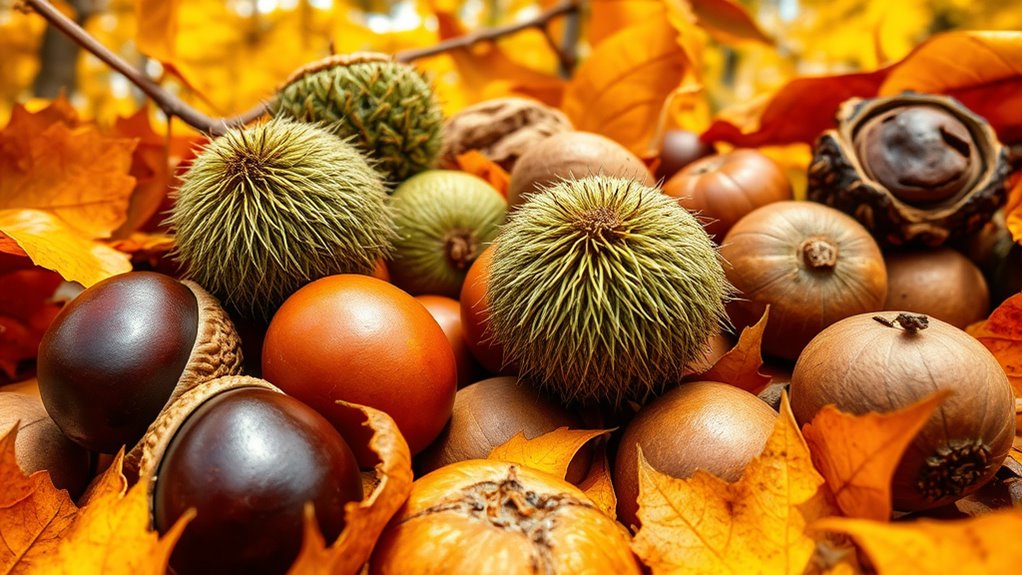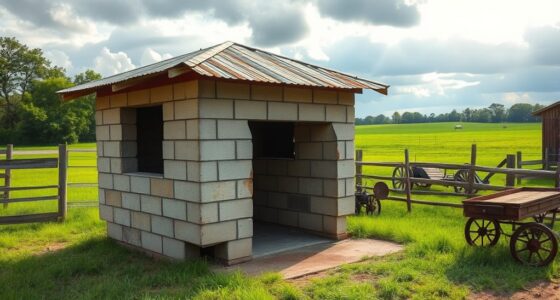In September, you can identify ripe edible nuts by looking for shells that have darkened, become dull, or hardened, and that loosen easily from their husks. Check for shells with the right color, cracks, or splits indicating dryness and maturity. Also, observe the tree—healthy nut trees have distinctive leaves and bark features. If you take a closer look, you’ll find more tips on safe harvesting and avoiding toxic look-alikes.
Key Takeaways
- Look for nuts with shells that change color, darken, or become dull, indicating ripeness.
- Check if nuts loosen easily from shells or husks, a sign of maturity.
- Listen for a hollow sound when shaking the nut, suggesting it’s ready for harvest.
- Observe shell firmness and texture—hard shells typically signal ripeness.
- Confirm nut tree species by identifying distinctive leaves and bark features to ensure edibility.
Common Nuts Found in September and Their Characteristics
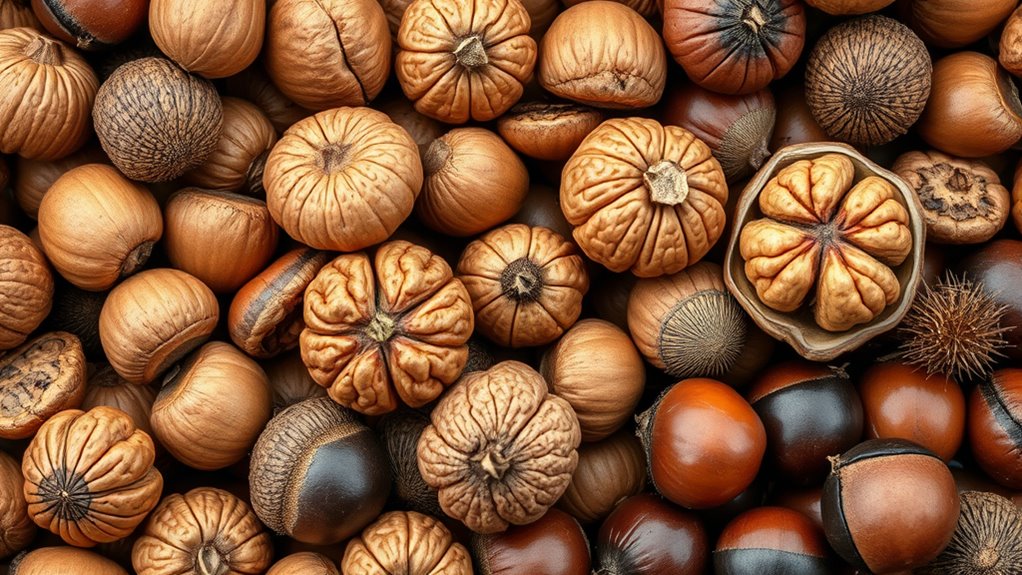
Have you ever wondered which nuts are ripe and available to harvest in September? This is the perfect time to spot nuts with specific characteristics, like shell thickness and flavor profiles. For example, walnuts have relatively thin shells that make them easier to crack, revealing rich, buttery nut flavors. In contrast, pecans possess thicker shells that require more effort but yield sweet, buttery notes once cracked open. Hazelnuts feature a smooth shell with a distinct, earthy flavor profile, making them popular for snacking or baking. Knowing these traits helps you identify which nuts are ready for harvest. Pay attention to shell firmness and the aroma of the nut inside, as these clues guide you to the best harvest time for each variety. Additionally, understanding nut ripening stages can further improve your harvesting timing and ensure optimal flavor and quality. Recognizing harvest readiness through visual and sensory cues is essential for a successful nut harvest. Proper nut identification can help prevent harvesting unripe nuts that might not have developed full flavor. Monitoring shell texture can also provide insight into whether nuts are mature enough to collect.
How to Differentiate Edible Nuts From Toxic Varieties

To tell edible nuts apart from toxic ones, you need to recognize their key features, like shape, shell texture, and color. Watch out for toxic look-alikes that mimic edible varieties but have distinct markings or abnormalities. Being able to identify these differences helps ensure your safety when foraging. Using proper identification techniques, such as examining the shell texture, can further reduce the risk of confusion with toxic nuts. Recognizing the nut shape and observing any irregularities or damage can also aid in distinguishing safe nuts from harmful ones.
Recognize Key Nut Features
Recognizing the key features that distinguish edible nuts from toxic varieties is essential for safe foraging. Focus on nut shell textures and size variations to identify safe options. Edible nuts often have smooth or slightly ridged shells, while toxic ones may have rough, spiky, or foul-smelling shells. Pay attention to size differences; edible nuts typically vary within a known range, whereas toxic nuts can be unexpectedly large or small. Look for consistent shell patterns and a firm, hard shell that protects the nut inside. If the shell feels unusually soft or brittle, it could be a warning sign. Additionally, understanding the shell textures can help you differentiate between safe and potentially harmful nuts. Recognizing nut shell features and their typical characteristics aids in avoiding dangerous varieties and ensures a successful harvest. Be cautious of distinctive odors, which may indicate toxicity in certain nut shells, so always handle with care and thorough inspection. Also, observing shell patterns can provide clues about the nut’s edibility and help prevent accidental consumption of toxic types. Awareness of toxicity signs in nuts further enhances safe foraging practices. Always double-check your findings before consuming any wild nuts.
Spot Toxic Look-Alikes
How can you tell if a nut is safe to eat when it looks similar to toxic varieties? First, learn to recognize poisonous look-alikes, which often mimic edible nuts but contain harmful toxins. Be cautious of toxic berry confusion, as some deadly plants produce berries that resemble nut shells or kernels. Always examine the nut’s shell, texture, and color carefully—poisonous varieties may have unusual markings, softer shells, or irregular shapes. Avoid nuts with mold, discoloration, or signs of damage. When in doubt, consult a regional plant guide or expert before consuming. Additionally, proper identification techniques are crucial in distinguishing safe nuts from toxic ones. When uncertain, it’s better to err on the side of safety.
Recognizing Nut Trees by Their Leaves and Bark
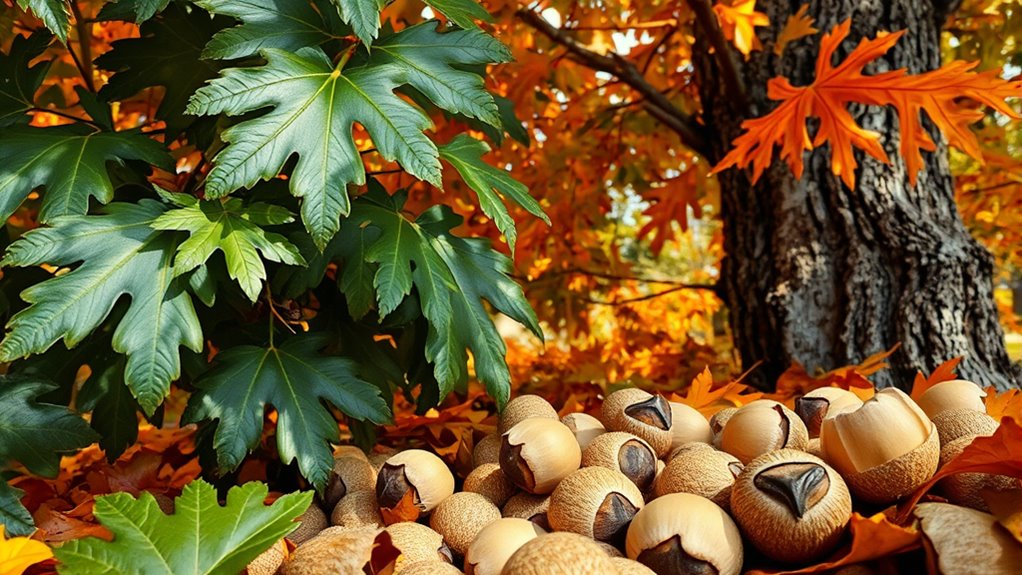
You can identify nut trees by paying close attention to their leaves and bark. Look for specific leaf shapes, such as serrated or compound leaves, that are unique to certain species. Additionally, examine the bark texture—whether it’s smooth, rough, or ridged—to help distinguish different nut trees from one another. Recognizing tree features like leaf arrangement and bark patterns can greatly enhance your identification skills. Observing the growth habit of the tree can also provide clues about its species, especially during the September harvest period. Being familiar with leaf morphology can further improve your ability to accurately identify nut trees in the wild.
Leaf Shape Indicators
Leaf shape is a key feature for identifying nut trees in the wild. By examining leaf shape indicators, you can distinguish different species effectively. Pay attention to leaf margin patterns, which vary among trees—some have smooth edges, while others feature serrated or lobed margins. These subtle differences are essential for accurate identification.
Consider these leaf characteristics:
- The overall shape, like oval, lanceolate, or heart-shaped
- Margin patterns, such as smooth, toothed, or lobed edges
- Leaf arrangement on the branch, whether opposite or alternate
- Vein patterns, which can be parallel or pinnate
Using these indicators helps you differentiate nut trees during harvest, ensuring you pick the right species and avoid confusion with inedible or toxic plants.
Bark Texture Clues
Bark texture offers valuable clues for identifying nut trees, complementing leaf shape indicators. By examining bark texture clues, you can distinguish different species and assess their identifying tree health. Bark texture can vary significantly among nut tree species, providing important identification markers. For example, smooth bark may indicate younger trees, while deeply furrowed or scaly bark often appears on mature specimens. Some trees feature rough, ridged bark that provides extra grip, whereas others have thin, peeling bark revealing layers beneath. Noticing irregularities like cracks, holes, or discoloration can also signal issues with tree health, such as disease or pests. These features help confirm tree species and ensure you’re harvesting from healthy, edible nut trees. Paying close attention to bark texture enhances your ability to accurately identify nut trees during September harvest, ensuring a fruitful and safe gathering process. Additionally, understanding tree health signs can help you avoid diseased or infested trees, safeguarding your harvest. Recognizing bark pattern variations can further refine your identification skills and improve your overall harvest quality, especially when combined with leaf shape indicators for more precise identification.
Signs of Ripe Nuts Ready for Harvesting

Knowing when nuts are ripe is essential for a successful harvest. Recognizing nut maturity indicators helps you determine the right time for nut harvesting. Look for these signs:
Properly identifying nut ripeness ensures a bountiful, flavorful harvest. Look for shell color change, looseness, sound, and cracks.
- Shell color change: Nuts often darken or develop a dull, matte finish.
- Ease of detachment: Ripe nuts usually loosen easily from their shells or husks.
- Sound test: Shake the nut; a hollow sound indicates maturity.
- Shell cracking or splitting: Some nuts, like walnuts, develop cracks when ready to harvest.
- Sensor-based maturity detection: Advanced sensors can help monitor nut ripeness by measuring moisture levels and shell firmness, ensuring precise harvest timing.
Pay attention to these indicators, as harvesting too early can lead to immature nuts that won’t store well, while waiting too long may cause nuts to fall and spoil. Accurate nut maturity indicators ensure a healthy, flavorful harvest. Additionally, understanding harvesting timing can help optimize the quality and yield of your nuts.
Safety Tips for Foraging and Handling Nuts
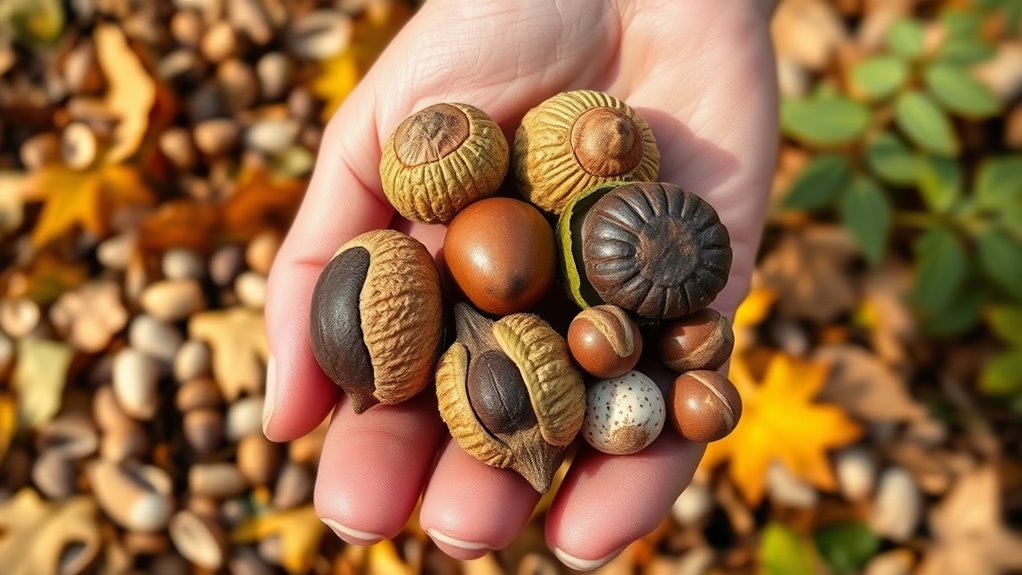
When foraging for nuts, it’s crucial to prioritize safety to prevent health risks and guarantee a successful harvest. Always stay aware of nut allergy awareness, as some nuts can cause severe reactions. If you’re unsure about a nut’s identity, avoid consuming it until you’ve confirmed it’s edible. Use seasonal foraging tips to identify nuts at their peak ripeness, which reduces the risk of collecting inedible or toxic varieties. Wear gloves and wash your hands thoroughly after handling nuts to minimize contamination and skin irritation. Keep your foraging area clean, and avoid collecting nuts near polluted sites or roads. Always verify your findings with reliable resources or expert advice. By following these safety tips, you ensure a safe and enjoyable foraging experience.
Seasonal Variations in Nut Appearance and Harvest Times
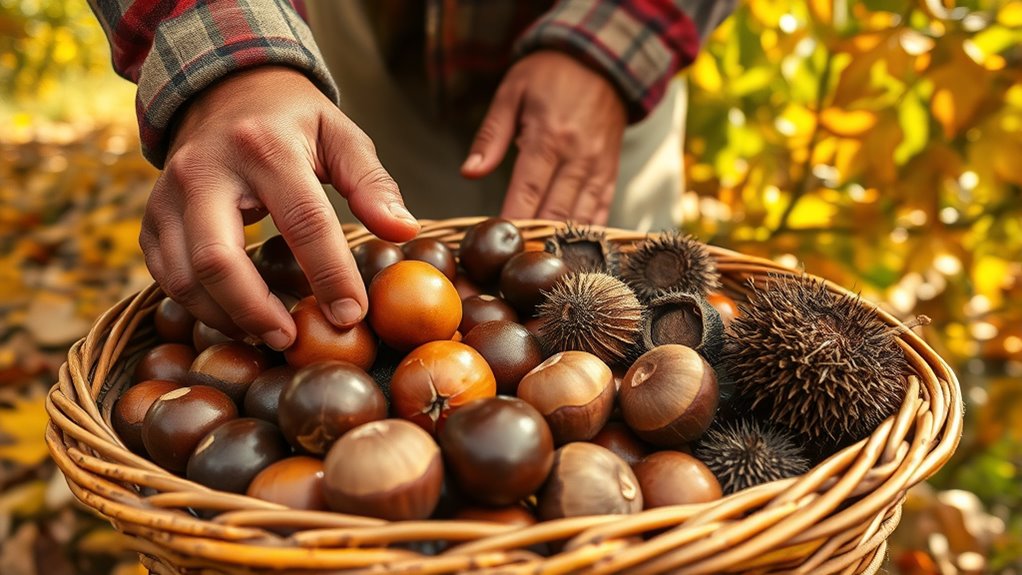
Understanding how nut appearances and harvest times change throughout the year can considerably improve your foraging success. Seasonal variations influence when and how nuts mature, so recognizing these changes helps you plan your nut harvesting effectively. During different times of the year, nuts may look different—harder shells, changes in color, or size—indicating ideal harvest windows. For example:
- Early fall: Nuts are often fully ripened, with shells hardening and nuts falling naturally.
- Late summer: Nuts may still be maturing, with softer shells and less developed kernels.
- Winter: Many nuts have already been harvested or fallen, requiring careful search.
- Spring: Little nut activity, focusing more on tree health and growth.
Staying aware of these seasonal cues enhances your seasonal foraging and ensures you gather nuts at their peak.
Tips for Proper Storage and Preservation of Gathered Nuts
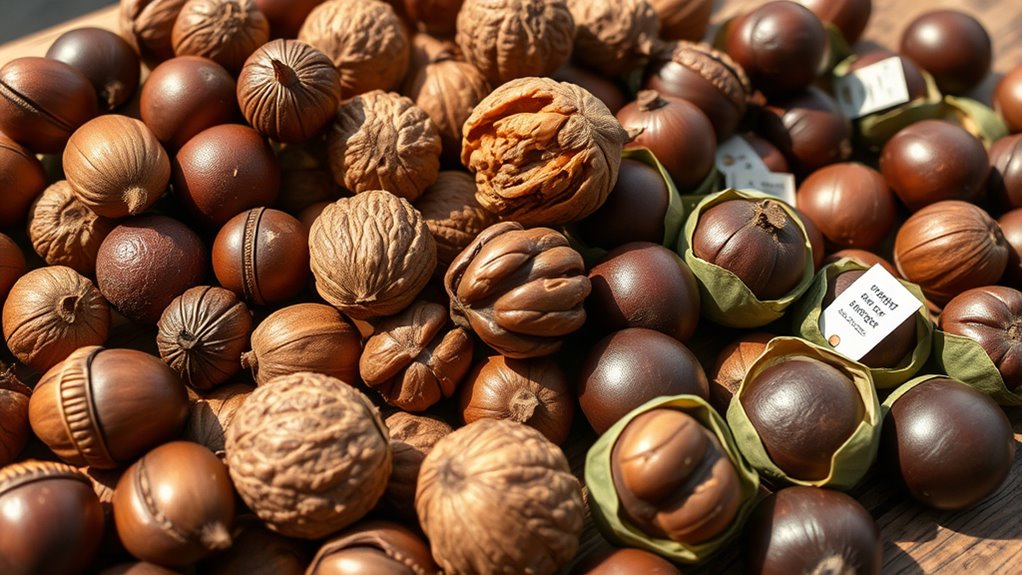
Proper storage and preservation are essential to keep your gathered nuts fresh and edible for as long as possible. To achieve this, focus on nut shell preservation by ensuring shells stay intact, which protects against moisture and pests. Use airtight nut storage containers to maintain a consistent, cool environment that prevents spoilage. Store nuts in a dry, dark place away from direct sunlight, as light can degrade quality. Regularly check your stored nuts for any signs of mold or insect activity, and remove affected nuts immediately. Properly shelled nuts should be kept in sealed containers in the refrigerator or freezer for extended freshness. By following these tips, you’ll maximize your harvest’s shelf life and enjoy your nuts at their best quality.
Frequently Asked Questions
Are There Any Common Nut Allergies I Should Be Aware of During Foraging?
Nut allergy awareness is vital when foraging, as common allergies include walnuts, hazelnuts, and pecans. You should always double-check the nuts you find, since cross-contamination can occur. Follow foraging safety tips like positively identifying nuts and avoiding unknown varieties. If you’re unsure about a nut’s safety, it’s best to skip it. Being cautious helps prevent allergic reactions and guarantees a safe foraging experience.
Can Nuts Be Foraged From Urban or Suburban Areas Safely?
Imagine urban foraging as exploring a hidden garden amidst skyscrapers, where every tree holds secrets. You can forage nuts safely in these areas if you master nut identification and know which trees are safe. Beware of pollution and potential allergens. Always verify the species before collecting, and avoid harvesting near busy roads or contaminated sites. With careful attention, urban foraging becomes a rewarding adventure in your city’s natural corners.
What Tools Are Recommended for Collecting Nuts During Harvest?
When collecting nuts during harvest, you should use nut shelling tools to efficiently crack and process the shells. Harvesting baskets are essential for gathering and carrying nuts without damaging them. These tools help you work quickly and safely in the field. Make sure to choose sturdy shellers and durable baskets that suit your harvest size. This way, you’ll maximize your yield while keeping your nuts in good condition.
How Can I Tell if a Nut Tree Is Protected or Private Property?
To determine if a nut tree is on protected or private property, look for property boundaries like fences, signs, or posted notices. Respect private land access by checking for any no trespassing signs or asking permission from landowners before entering. If you’re unsure, it’s best to stay on public land or seek permission to avoid trespassing and make certain you’re respecting property rights. Always verify boundaries to avoid legal issues.
Are There Any Local Regulations or Permits Required for Nut Foraging?
Ah, the days of yore when foraging was a common skill! Today, you need to verify local regulations before nut foraging. Permit requirements vary by land ownership—public lands often need permits, while private property requires landowner permission. Always confirm if any permits are necessary to avoid fines or trespassing issues. Being informed ensures you enjoy foraging responsibly and legally during September’s bounty.
Conclusion
As you explore September’s bounty of nuts, remember that knowledge is your best tool. With keen eyes and careful identification, you can enjoy nature’s treasure without falling for false promises. Trust your instincts and don’t put all your eggs in one basket—be cautious and well-informed. When in doubt, wait for the perfect moment to harvest and always prioritize safety. After all, a little caution goes a long way in turning foraging into a rewarding adventure.

